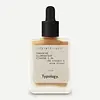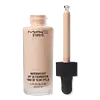Typology Tinted Serum Vitamin C, Squalane & Aloe Vera Versus Mac Cosmetics Studio Waterweight SPF 30 Foundation
What's inside
What's inside
 Key Ingredients
Key Ingredients

 Benefits
Benefits

 Concerns
Concerns

 Ingredients Side-by-side
Ingredients Side-by-side

Water
Skin ConditioningIsoamyl Laurate
EmollientC9-12 Alkane
SolventSqualane
EmollientPolyglyceryl-3 Diisostearate
EmulsifyingPropanediol
SolventSilica
AbrasivePolyglyceryl-6 Polyricinoleate
EmulsifyingGlycerin
HumectantMagnesium Sulfate
Ascorbyl Tetraisopalmitate
AntioxidantPolyglyceryl-2 Isostearate
EmulsifyingCoco-Caprylate/Caprate
EmollientDisteardimonium Hectorite
StabilisingHydroxyethylcellulose
Emulsion StabilisingSodium Benzoate
MaskingDisodium Stearoyl Glutamate
CleansingPotassium Sorbate
PreservativeAloe Barbadensis Leaf Juice
Skin ConditioningAluminum Hydroxide
EmollientSodium Nitrate
SoothingCI 77891
Cosmetic ColorantCI 77492
Cosmetic ColorantCI 77491
Cosmetic ColorantCI 77499
Cosmetic ColorantWater, Isoamyl Laurate, C9-12 Alkane, Squalane, Polyglyceryl-3 Diisostearate, Propanediol, Silica, Polyglyceryl-6 Polyricinoleate, Glycerin, Magnesium Sulfate, Ascorbyl Tetraisopalmitate, Polyglyceryl-2 Isostearate, Coco-Caprylate/Caprate, Disteardimonium Hectorite, Hydroxyethylcellulose, Sodium Benzoate, Disodium Stearoyl Glutamate, Potassium Sorbate, Aloe Barbadensis Leaf Juice, Aluminum Hydroxide, Sodium Nitrate, CI 77891, CI 77492, CI 77491, CI 77499
Ethylhexyl Methoxycinnamate 5%
UV AbsorberTitanium Dioxide 3.1%
Cosmetic ColorantZinc Oxide 2.1%
Cosmetic ColorantWater
Skin ConditioningMethyl Trimethicone
Skin ConditioningPhenyl Trimethicone
Skin ConditioningSilica
AbrasiveButyloctyl Salicylate
Skin ConditioningDimethicone
EmollientNeopentyl Glycol Diheptanoate
EmollientC12-15 Alkyl Benzoate
AntimicrobialButylene Glycol
HumectantDimethicone Silylate
Lauryl PEG-9 Polydimethylsiloxyethyl Dimethicone
Skin ConditioningEthylhexyl Palmitate
EmollientGlycerin
HumectantPolysilicone-11
Citrus Medica Vulgaris Fruit Extract
AntioxidantSodium Hyaluronate
HumectantLecithin
EmollientPyrus Malus Fruit Extract
Skin ConditioningLens Esculenta Fruit Extract
Skin ConditioningGlycine Soja Protein
EmulsifyingLitchi Chinensis Seed Extract
Skin ConditioningLaminaria Saccharina Extract
Skin ProtectingPEG-10 Dimethicone
Skin ConditioningTocopheryl Acetate
AntioxidantMethicone
EmollientTrimethylsiloxysilicate
EmollientSodium PCA
HumectantSodium Lactate
BufferingThermus Thermophillus Ferment
Skin ConditioningTriethyl Citrate
MaskingLaureth-7
EmulsifyingSilica Dimethyl Silylate
EmollientPolymethylsilsesquioxane
Magnesium Aluminum Silicate
AbsorbentXanthan Gum
EmulsifyingDimethicone/PEG-10/15 Crosspolymer
Sodium Chloride
MaskingDextrin
AbsorbentTriethoxycaprylylsilane
Disteardimonium Hectorite
StabilisingCaprylyl Glycol
EmollientHexylene Glycol
EmulsifyingPolyglutamic Acid
Skin ConditioningZinc Stearate
Cosmetic ColorantDisodium EDTA
Phenoxyethanol
PreservativePotassium Sorbate
PreservativeSodium Dehydroacetate
PreservativeMica
Cosmetic ColorantCI 77891
Cosmetic ColorantCI 77491
Cosmetic ColorantCI 77492
Cosmetic ColorantCI 77499
Cosmetic ColorantEthylhexyl Methoxycinnamate 5%, Titanium Dioxide 3.1%, Zinc Oxide 2.1%, Water, Methyl Trimethicone, Phenyl Trimethicone, Silica, Butyloctyl Salicylate, Dimethicone, Neopentyl Glycol Diheptanoate, C12-15 Alkyl Benzoate, Butylene Glycol, Dimethicone Silylate, Lauryl PEG-9 Polydimethylsiloxyethyl Dimethicone, Ethylhexyl Palmitate, Glycerin, Polysilicone-11, Citrus Medica Vulgaris Fruit Extract, Sodium Hyaluronate, Lecithin, Pyrus Malus Fruit Extract, Lens Esculenta Fruit Extract, Glycine Soja Protein, Litchi Chinensis Seed Extract, Laminaria Saccharina Extract, PEG-10 Dimethicone, Tocopheryl Acetate, Methicone, Trimethylsiloxysilicate, Sodium PCA, Sodium Lactate, Thermus Thermophillus Ferment, Triethyl Citrate, Laureth-7, Silica Dimethyl Silylate, Polymethylsilsesquioxane, Magnesium Aluminum Silicate, Xanthan Gum, Dimethicone/PEG-10/15 Crosspolymer, Sodium Chloride, Dextrin, Triethoxycaprylylsilane, Disteardimonium Hectorite, Caprylyl Glycol, Hexylene Glycol, Polyglutamic Acid, Zinc Stearate, Disodium EDTA, Phenoxyethanol, Potassium Sorbate, Sodium Dehydroacetate, Mica, CI 77891, CI 77491, CI 77492, CI 77499
 Reviews
Reviews

Ingredients Explained
These ingredients are found in both products.
Ingredients higher up in an ingredient list are typically present in a larger amount.
Ci 77491 is also hydrated iron III oxide. It's sole purpose is to give a red/pink hue to products.
Iron III oxides are classified as inorganic chemicals for coloring.
Synthetically created Ci 77491 is considered safer than those naturally found. This is because the synthetically created version may contain less impurities. Iron oxides are generally non-toxic and non-allergenic.
Learn more about CI 77491Ci 77492 is also hydrated iron III oxide. It's sole purpose is to give a yellow hue to products.
Iron III oxides are classified as inorganic chemicals for coloring.
Synthetically created Ci 77492 is considered safer than those naturally found. This is because the synthetically created version may contain less impurities. Iron oxides are generally non-toxic and non-allergenic.
Learn more about CI 77492Ci 77499 is also hydrated iron III oxide. It is created from mixing red and black iron oxides. This helps give shades of darkness to a product.
Iron III oxides are classified as inorganic chemicals for coloring.
Ci 77891 is a white pigment from Titanium dioxide. It is naturally found in minerals such as rutile and ilmenite.
It's main function is to add a white color to cosmetics. It can also be mixed with other colors to create different shades.
Ci 77891 is commonly found in sunscreens due to its ability to block UV rays.
Learn more about CI 77891Disteardimonium Hectorite comes from the clay mineral named hectorite. It is used to add thickness to a product.
It can also help stabilize a product by helping to disperse other ingredients.
Hectorite is a rare, white clay mineral.
Learn more about Disteardimonium HectoriteGlycerin is already naturally found in your skin. It helps moisturize and protect your skin.
A study from 2016 found glycerin to be more effective as a humectant than AHAs and hyaluronic acid.
As a humectant, it helps the skin stay hydrated by pulling moisture to your skin. The low molecular weight of glycerin allows it to pull moisture into the deeper layers of your skin.
Hydrated skin improves your skin barrier; Your skin barrier helps protect against irritants and bacteria.
Glycerin has also been found to have antimicrobial and antiviral properties. Due to these properties, glycerin is often used in wound and burn treatments.
In cosmetics, glycerin is usually derived from plants such as soybean or palm. However, it can also be sourced from animals, such as tallow or animal fat.
This ingredient is organic, colorless, odorless, and non-toxic.
Glycerin is the name for this ingredient in American English. British English uses Glycerol/Glycerine.
Learn more about GlycerinPotassium Sorbate is a preservative used to prevent yeast and mold in products. It is commonly found in both cosmetic and food products.
This ingredient comes from potassium salt derived from sorbic acid. Sorbic acid is a natural antibiotic and effective against fungus.
Both potassium sorbate and sorbic acid can be found in baked goods, cheeses, dried meats, dried fruit, ice cream, pickles, wine, yogurt, and more.
You'll often find this ingredient used with other preservatives.
Learn more about Potassium SorbateSilica, also known as silicon dioxide, is a naturally occurring mineral. It is used as a fine, spherical, and porous powder in cosmetics.
Though it has exfoliant properties, the function of silica varies depending on the product.
The unique structure of silica enhances the spreadability and adds smoothness, making it a great texture enhancer.
It is also used as an active carrier, emulsifier, and mattifier due to its ability to absorb excess oil.
In some products, tiny microneedles called spicules are made from silica or hydrolyzed sponge. When you rub them in, they lightly polish away dead skin layers and enhance the penetration of active ingredients.
Learn more about SilicaWater. It's the most common cosmetic ingredient of all. You'll usually see it at the top of ingredient lists, meaning that it makes up the largest part of the product.
So why is it so popular? Water most often acts as a solvent - this means that it helps dissolve other ingredients into the formulation.
You'll also recognize water as that liquid we all need to stay alive. If you see this, drink a glass of water. Stay hydrated!
Learn more about Water